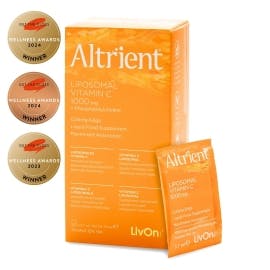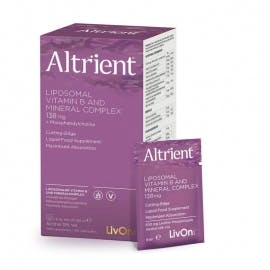Why Do Pregnancy and Menopause Trigger Hair Loss?
Like many of the constant things in life we take our hair for granted, thick or thin curly or straight, it’s always there and for the most part needs very little attention. At least nothing a regular visit to the hairdressers can’t sort out.
However, a good head of hair isn’t necessarily a given throughout all life’s stages and any sudden or extreme loss can cause significant emotional distress and anxiety. Identifying the underlying cause of hair loss can help to prevent it happening and can also give you options for managing an existing condition. Hopefully, with a few lifestyle changes and some carefully chosen nutrients you can look forward to strong, healthy hair.
The Hair Growth Cycle
Hair is grown from a follicle and built from cells similar to those of our skin, which is composed primarily of the protein keratin. The blood capillaries surrounding each follicle carry nourishment needed for hair-cell reproduction and growth. Hair grows in three phases known as anagen, catagen and telogen:
- Anagen – is the growth stage and can last from weeks to years.
- Catagen - the hair cells die.
- Telogen – is the resting stage, when hair is shed and lasts for one to three months.
Only a small amount of hair follicles are lost at any one time and on average we lose around 90 scalp hairs a day. The health of your hair depends on the circulation to the root and the amount of nutrients and hormones present in the blood. Sufficient protein in the diet is also of particular importance with respect to hair strength and elasticity. Poor nutrition and circulation will therefore lead to poor hair growth and condition, whereas an increase in blood flow to an area may enhance hair growth.
Why Does Hair Loss Happen?
Alopecia is the medical term for hair loss and is surprisingly common. On average around 70% of women over 70 years old, experience female-pattern baldness, which is thought to be inherited1. There may be several contributing factors for hair loss, although at times there is no obvious cause. Often it is due to one of the following:
Nutritional deficiencies
The scalp has a very high turnover of hair follicle cells requiring a constant supply of nutrients and energy. Low protein intake, a lack of calories or a deficiency of vitamins, minerals and essential fatty acids can lead to hair loss and structural abnormalities. As well as this, imbalances in the gut flora, gluten sensitivity and the medical condition Coeliac2 have also been shown to result in hair loss.
Ageing
A follicle only has a limited number of cycles. After the age of forty hair growth slows and isn’t replaced as quickly as it is shed. This leads to thinning and for some - a degree of baldness or alopecia which occurs in both sexes, although much less dramatically amongst women.
Medical treatments, drugs and chemical use
Hair loss is a well-known side effect of cancer treatments that include chemotherapy. Side effects from some medications also cause hair loss. Chemicals used to dye, perm or straighten hair can cause damage and weaken hair.
Stress and physical or emotional trauma
Fevers, haemorrhage, severe illness, tumours, alcoholism and stress can contribute to hair loss. Significant stress is thought to push large numbers of hair follicles into the telogen (resting) phase, so hair may fall out suddenly when you wash or brush it. This hair loss is not necessarily permanent if you can find ways to manage your stress levels.
Hormone imbalances
An imbalance in male hormones called ‘androgens’ is related to hair thinning and occurs in both men and women. Poor thyroid function as well as hormone changes post-pregnancy and menopause can lead to hair loss. In women, hair loss is more common after the menopause, which is likely due to hormonal changes as the human hair follicle is uniquely hormone-sensitive3.
It is well established that low thyroid function can cause hair loss, not just on the head but all over the body4. The thyroid hormone is essential for the development and maintenance of the hair follicle, so if it’s out of balance, it may result in hair loss. According to research, thyroid hormones directly alter human hair follicle functions. They do this by prolonging the effects of anagen (the growth stage) and by stimulating hair proliferation as well as altering hair pigmentation5.
Post-childbirth
During pregnancy, many women report that their hair is thick and lustrous, this is due to hormonal changes that increase the number of hair follicles in the anagen phase for longer periods. The hair follicles return to the telogen (shedding)phase within 3–6 months of delivery with a sudden drop in hormone levels6. This results in accelerated hair loss, so it’s quite common for women to lose more hair than usual up to 3 months after giving birth. This can be quite alarming, but as hormone levels gradually re-balance, hair growth returns to normal.
Hair Loss Prevention
It’s clear that there are many dietary and lifestyle factors to consider when creating a prevention strategy for hair loss. In general, a combination of optimum nutrition, stress reduction and correcting underlying hormonal imbalances has proven to be the most effective solution for hair loss. Regular stimulating scalp massage helps too!
All the information you need for strong healthy hair is in these 3 important guidelines:
1.Feed Your Hair From Within
The body regards hair as non-essential, so it’s often the first thing that suffers if you neglect your health. This means a healthy balanced nutrient-rich diet is the best way forward if you want to keep your hair in tip-top condition. Keeping your foods varied will provide a good range of the nutrients that are essential for feeding the hair follicle, improving circulation to the scalp and supplying the building blocks for strong hair growth. Your healthy hair nutrition plan should include:
Antioxidants
Studies suggest follicle cells from balding scalps are more susceptible to oxidative stress7, leading to hair loss if antioxidants are in short supply. The body has a wide range of defence nutrients that have been shown to contribute to the protection of cells from oxidative stress including vitamin B2, vitamin C, vitamin E, copper, manganese, selenium, zinc. To ensure your diet contains a broad range of different antioxidants, eat a rainbow of fruit and vegetables every day - antioxidants give plant foods their vibrant colours.
Altrient C is a great standby supplement to support your diet if you’re finding it hard to get enough fruit and veg every day. The liposome technology Altrient uses has far superior absorption compared to standard oral supplements, so you can rest assured this important defence nutrient will be making its way rapidly to your hair follicles.
B Vitamins
Healthy hair is dependent on B complex vitamins which are found in meat, wholegrains and green leafy vegetables. This important group of vitamins perform essential roles in a vast array of cellular functions including acting as coenzymes for the synthesis of fatty acids8. These are essential for the health and flexibility of the cell membranes, keeping hair strong and lubricated.
Deficiencies in the B vitamins, particularly folate and biotin may contribute to the undernourishment of hair follicle cells. Folate is important because of its contribution to normal amino acid synthesis, which is essential for the creation of keratin the protein hair is made up of. Biotin is another B vitamin known to contribute to the maintenance of normal hair. Evidence indicates that 38% of women complaining of hair loss have a deficiency of biotin10. Research on sufferers of alopecia found that 200mcg biotin daily had positive effects on healthy hair growth.
Almost half of daily biotin is produced in the gut by healthy intestinal bacteria. Studies suggest that biotin deficiency can occur in those with compromised intestinal microbiota. Those with a history of gluten sensitivity are more prone to biotin deficiency for this reason. Eating a diet rich in fibre helps to maintain beneficial levels of microflora in the gut.
Biotin
Found in a number of foods, bananas have the highest concentration, but most legumes (including peanuts and lentils) are also biotin-rich. Those with dietary restrictions or compromised absorption can benefit from well absorbed liposomal formulas such as Altrient B, which carries the nutrients directly to the blood and to the cells avoiding complicated digestive problems.
Chromium
Maintaining normal blood sugar levels helps to keep stress in check, which can be a major factor in hair loss. Chromium picolinate has been shown to improve blood glucose control.
Iron
Low iron status frequently causes hair shedding in women. Insufficient iron means your body can’t carry oxygen around the blood efficiently, and growth and repair of the hair follicles is affected. Good sources of iron are red meat, particularly organ meats, pumpkin seeds, shellfish, tofu, legumes, spinach and dark chocolate.
Omega 3 Essential Fatty Acids
These are important for keeping the scalp and hair lubricated, flexible and hydrated. Low levels of omega 3s can lead to dry, brittle and dull hair. Oily fish, grass-fed beef, walnuts, linseeds and cold-pressed flax oil are good sources of omega 3s.
Protein
Protein is essential for the growth and repair of all bodily tissues including hair. Your body needs protein to produce keratin. A diet low in protein can affect keratin-rich tissues – contributing to hair thinning and loss.
Selenium
Selenium plays a role in the lifecycle of the hair follicle; this is probably connected with its contribution to normal thyroid function. The recommended daily intake of selenium is 60mcg for women and 75mcg for men. Brazil nuts contain around 70mcg per nut, depending on where they were grown.Meat, fish and eggs also contain high amounts of selenium.
Vitamin C
This vitamin is crucial for the production and maintenance of collagen, the connective tissue found within hair follicles. Because vitamin C contributes to normal collagen formation and to the protection of cells from oxidative stress it plays a key role in protecting hair follicle cells and nearby blood vessel cells that supply nutrients and oxygen to the scalp. Vitamin C increases iron absorption which is also vital for oxygen transportation to the scalp. Broccoli, kale, bell peppers, strawberries and citrus fruits are all rich sources of vitamin C.
Zinc
Low zinc levels have been found to lead to hair loss and brittle hair11. The main dietary sources of zinc are meat and fish.
2. Keep Hormone Balance Under Control
Restoring hormonal balance is a whole-body concept which involves changes to nutrient intake, lifestyle and environment. The first step in the right direction to happier hormone levels is to eat a well-balanced diet. What you eat can directly affect hormone synthesis and secretion, so you need to choose foods that contribute to healthy hormone function. Hair loss responds very well to nutrition therapy, so try including:
- Good quality lean protein such as chicken, fish, eggs, nuts and seeds.
- Plenty of healthy fats found in oily fish, olives, coconuts, avocados, nuts and seeds.
- At least three portions of organic fruit and five to seven vegetables daily. Organic food is grown in soil that is not mineral deficient so is more nutrient-dense and leaves you less exposed to toxins and chemicals11 that may alter hormone balance.
- Plenty of fibre – found in vegetables, nuts and seeds. Fibre promotes regular bowel movements and helps to carry used hormones out of the body, preventing them from re-circulating and causing excesses.
- Lots of fluid – two to three glasses of water daily, topped up with herbal teas or diluted fruit juice. If your cells don’t gain sufficient water, they cannot function efficiently which can affect the detoxification of tissues leading to glandular dysfunction and hormonal imbalance12.
- Keep away from packaged and sugar-laden processed foods that raise blood glucose levels triggering a stress response and avoid alcohol and caffeine, which are stimulants that activate the release of adrenalin.
- Phytoestrogen rich foods, such as linseeds, nuts, apples, fennel, celery, alfalfa and parsley play a key role in hormone balance. Phytoestrogens are compounds that gently mimic natural oestrogen and can bind to oestrogen receptors. This has the advantage of either blocking the uptake of oestrogen if the body has too much or raising levels of oestrogen where there is too little, helping to balance hormone levels.
3. Manage Stress
From a dietary perspective, the aim is to control blood sugar fluctuations, (which can trigger stress hormones). Ideally you want to focus on a low-GI Mediterranean style diet; rich in vegetables, fruits and whole grains, which also includes fish, pulses, nuts, seeds and legumes as a source of proteins.
Avoid stimulant drinks like coffee that can raise levels of the stress hormone cortisol and replace with herbal teas or barley cup (a caffeine-free coffee substitute). Try breathing techniques at night to promote restful sleep and find time each day to get some exercise.
Manage your stress levels firstly by avoiding situations which you know are stressful. Then use techniques that have been shown to lower blood pressure, reduce stress and create a relaxed feeling of wellbeing such as meditation, yoga, peaceful calming music, and deep breathing exercises.
Get at least eight hours sleep by ensuring you sleep in a dark room, switch off gadgets, avoid late-night caffeine drinks, take a hot bath with Epsom salts (magnesium relaxes the muscles), ban TV from the bedroom and avoid reading too.
4. Exercise
Exercise wins hands down as a stress buster and sleep enhancer! Moving more and sitting less helps to improve circulation, detoxification and nutrient delivery for hormones. Numerous studies have shown that exercise reduces stress, improves sleep and bumps up the happy hormones keeping you smiling longer. Just thirty minutes of exercise a day is all you need to experience the stress-relieving benefits.
Seeking advice for hair loss
There are medical hair lotions that have been found to be effective for hair loss, but you need to contact your GP first before starting any medications or treatments for alopecia. If you have hair loss that is significantly affecting your quality of life, it can be helpful to speak to others who have alopecia. You can find an alopecia support group at https://www.alopecia.org.uk/Pages/Category/find-a-support-group?Take=10.
If you want to take a natural approach but need more individualised dietary advice you can find a qualified nutritional therapist or naturopath at https://bant.org.uk/
Jacqueline Newson BSc (Hons) Nutritional Therapy
REFERENCES
Upton JH, Hannen RF, Bahta AW, Farjo N, Farjo B, Philpott MP. Oxidative stress-associated senescence in dermal papilla cells of men with androgenetic alopecia. J Invest Dermatol. 2015 May;135(5):1244-1252. doi: 10.1038/jid.2015.28.
Fessatou S, Karpathios T and Kostaki M. Coeliac disease and alopecia areata in childhood. Journal of paediatrics and child health 2003; 39,2. https://doi.org/10.1046/j.1440-1754.2003.00116.x.
Bodo E et al. Human female hair follicles are a direct, nonclassical target for thyroid-stimulating hormone. Journal of investigative dermatology 2009; 129: 1126-1139.
Vincent M, Yogiraj K. A Descriptive Study of Alopecia Patterns and their Relation to Thyroid Dysfunction. Int J Trichology. 2013;5(1):57-60. doi:10.4103/0974-7753.114701.
Nina van Beek, Enikő Bodó, Arno Kromminga, Erzsébet Gáspár, Katja Meyer, Michal A. Zmijewski, Andrzej Slominski, Björn E. Wenzel, Ralf Paus, Thyroid Hormones Directly Alter Human Hair Follicle Functions: Anagen Prolongation and Stimulation of Both Hair Matrix Keratinocyte Proliferation and Hair Pigmentation, The Journal of Clinical Endocrinology & Metabolism, Volume 93, Issue 11, 1 November 2008, Pages 4381–4388, https://doi.org/10.1210/jc.2008-0283.
Ekmekc TR & Gizlenti S.The changes in the hair cycle during gestation and the post‐partum period. JEADV 2013; 28,7. https://doi.org/10.1111/jdv.12188.
Upton JH, Hannen RF, Bahta AW, Farjo N, Farjo B, Philpott MP. Oxidative stress-associated senescence in dermal papilla cells of men with androgenetic alopecia. J Invest Dermatol. 2015 May;135(5):1244-1252. doi: 10.1038/jid.2015.28.
Kennedy DO. B Vitamins and the Brain: Mechanisms, Dose and Efficacy--A Review. Nutrients. 2016;8(2):68. Published 2016 Jan 27. doi:10.3390/nu8020068.
Trüeb RM. Serum Biotin Levels in Women Complaining of Hair Loss. Int J Trichology. 2016;8(2):73-77. doi:10.4103/0974-7753.188040.
Almohanna HM, Ahmed AA, Tsatalis JP, Tosti A. The Role of Vitamins and Minerals in Hair Loss: A Review. Dermatol Ther (Heidelb). 2019;9(1):51-70. doi:10.1007/s13555-018-0278-6.
Nina van Beek, Enikő Bodó, Arno Kromminga, Erzsébet Gáspár, Katja Meyer, Michal A. Zmijewski, Andrzej Slominski, Björn E. Wenzel, Ralf Paus, Thyroid Hormones Directly Alter Human Hair Follicle Functions: Anagen Prolongation and Stimulation of Both Hair Matrix Keratinocyte Proliferation and Hair Pigmentation, The Journal of Clinical Endocrinology & Metabolism, Volume 93, Issue 11, 1 November 2008, Pages 4381–4388, https://doi.org/10.1210/jc.2008-0283.
Trüeb RM. Serum Biotin Levels in Women Complaining of Hair Loss. Int J Trichology. 2016;8(2):73-77. doi:10.4103/0974-7753.188040.





